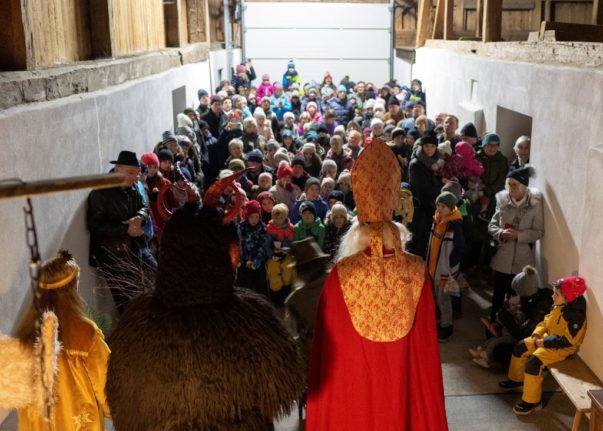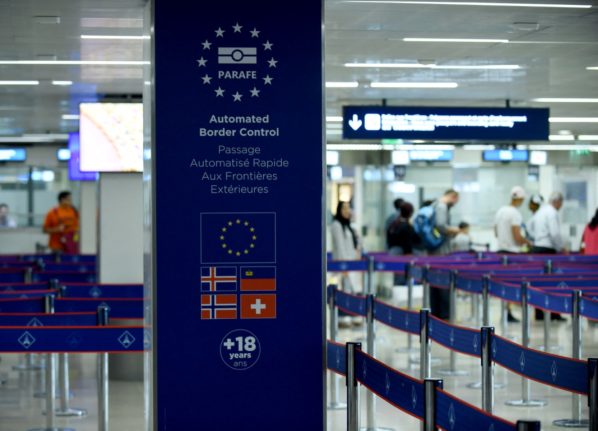Is Nikolaus the same as Santa Claus?
Though they have similar outfits, Nikolaus (also known as Nikolo) is not to be confused with Santa Claus, who is not a figure of Austrian Christmas celebrations. Many religious families focus more on Nikolaus earlier in December to ensure that Christmas is actually about Jesus’ birth and not presents from an Americanised and commercialised Santa.
Who is Nikolaus, then?
Each year on December 6th, Austrians (and Germans) remember the death of Nicholas of Myra (now the Anatolia region of modern Turkey), who died on that day in 346. He was a Greek Christian bishop known for miracles and giving gifts secretly and is now the patron saint of little children, sailors, merchants and students.
READ ALSO: Austrian Christmas traditions: The festive dates you need to know
Why do children set their shoes out on the night of December 5th?
The custom began because the historical St. Nicholas had a reputation for leaving secret gifts, such as coins, in people’s shoes overnight. Kids traditionally put out their boots, though shoes or stockings will suffice for those without boots.
And the boots have to be polished first?
Definitely. Dirty boots are unacceptable. Children polish their shoes to show they’ve been good. They usually place just one boot outside their door, so they don’t appear too greedy, though.
What do naughty children get?
This depends on different family traditions. Sometimes Nikolaus only leaves a switch (of wood) in the boot, ostensibly for spankings, to show that the child doesn’t deserve a treat. In other families, a man disguised as St. Nicholas will visit the family or the child’s school alone or with his sinister-looking alter ego, Knecht Ruprecht, to question the children about their behaviour.
READ ALSO: Everything that changes in Austria in December 2022
What does his outfit look like?
He is usually pictured with a long white beard, a bishop’s mitre and a red cloak, sometimes with a sack over his shoulder and a rod in his hand.
Does Nikolaus come again on Christmas Eve, then?
No. There is no Santa Claus or Father Christmas in Austria. Instead, it is the “Christkind” (literally Christ Child, or baby Jesus) who brings the presents on Christmas eve.
He looks much like a Cherubin and children are told that he brings the presents, rings a bell and lights up the Christmas tree.
The whole experience may seem curious to those watching for the first time: kids are lured into a separate room and the adults run to get gifts from the secret hiding places, set up the scene, turn on the tree lights and turn off other lights. Some then ring a small bell and the children are surprised to learn that they barely missed the winged baby who brought all the gifts.
READ ALSO: 8 things to know if you’re visiting Austria in December
Where can I see St Nikolaus?
Many cities organise walks and parades with St. Nikolaus, so it’s not uncommon to see him on his day or around it. For example, in Vienna, the city promotes the St. Nikolaus visits to markets. This is where you can find him:
On December 6th:
10-11 am Rochusmarkt, 1030 Wien
10-11 am Viktor-Adler-Markt, 1100 Wien
11:30-12:30 Naschmarkt, 1060 Wien
11:30-12:30 Hannovermarkt, 1200 Wien
01-2 pm Meidlinger Markt, 1120 Wien
01-2 pm Brunnenmarkt, 1160 Wien
02:30-3:30 pm Floridsdorfer Markt, 1210 Wien
02:30-3:30 pm Meiselmarkt, 1150 Wien
On December 7th:
01-2 pm: Vorgartenmarkt, 1020 Wien
02:30-3:30 pm Karmelitermarkt, 1020 Wien
02:30-3:30 pm Kutschkermarkt, 1180 Wien
04-5 pm Volkertmarkt, 1020 Wien
On December 15th:
02-03 pm: Matznermarkt, 1140 Wien
Frohen Nikolaustag!
READ ALSO: What are Austria’s last posting dates for Christmas 2022?



 Please whitelist us to continue reading.
Please whitelist us to continue reading.
Member comments